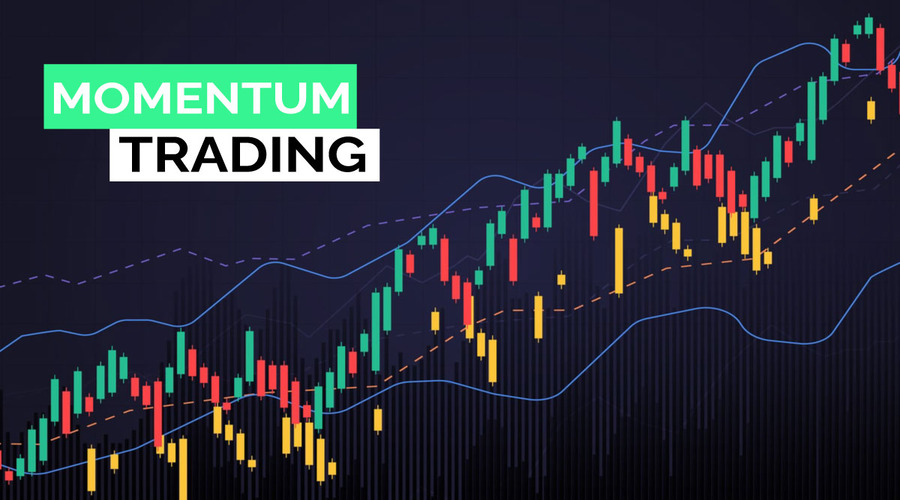Introduction
Cryptocurrencies have gained significant popularity in recent years, attracting both investors and traders looking to profit from this emerging asset class. One popular approach to trading cryptocurrencies is momentum trading. Momentum trading strategies aim to capitalize on the momentum exhibited by a cryptocurrency’s price movement, whether it’s an upward or downward trend. In this article, we will explore various momentum trading strategies and how they can be applied in the cryptocurrency space.
Understanding Momentum Trading Strategies
Momentum trading strategies rely on the principle that assets that have been trending strongly in one direction are likely to continue moving in the same direction for a certain period. Traders employing momentum strategies aim to enter trades when the momentum is strong and exit before the trend reverses. By following the momentum, traders seek to profit from short-term price movements.
Momentum trading strategies are a popular approach used by traders to capitalize on the strength and persistence of price trends in financial markets. Here are some key points to understand about momentum trading strategies:
- Trend Identification: Momentum traders focus on identifying strong trends in the market, whether they are upward (bullish) or downward (bearish). They aim to enter trades in the direction of the prevailing trend, expecting that the momentum will continue.
- Price Confirmation: Momentum traders often wait for price confirmation before entering a trade. This means they look for significant price movements or breakouts that indicate a continuation of the trend. By waiting for confirmation, traders seek to reduce the risk of entering trades too early or during price consolidations.
- Time Frame: Momentum trading strategies are typically applied to short-term time frames, such as intraday or daily charts. Traders focus on capturing relatively quick gains by entering and exiting trades within a short period.
- Technical Indicators: Traders use various technical indicators to identify and confirm momentum in the market. These indicators can include moving averages, oscillators, volume analysis, and trendlines. By analyzing these indicators, traders aim to gauge the strength and sustainability of the current trend.
- Risk Management: Like any trading strategy, risk management is crucial in momentum trading. Traders set predefined risk parameters, such as stop-loss orders, to limit potential losses if the trade goes against them. They also consider position sizing techniques to ensure that each trade’s risk is within their acceptable limits.
- Exit Strategy: Momentum traders typically have predefined exit points to lock in profits or cut losses. These exit points can be based on technical indicators, such as moving average crossovers or trendline breaks, or specific profit targets.
- Volatility Consideration: Momentum traders often prefer markets with sufficient volatility, as it provides opportunities for significant price movements. Higher volatility can lead to faster and more substantial gains, but it also carries increased risk.
- Continuous Monitoring: Successful momentum traders continuously monitor their trades and market conditions. They stay updated on news, economic events, and any factors that could impact the momentum of their chosen assets.
By understanding these key aspects of momentum trading strategies, traders can develop a systematic approach to identify and capitalize on trends, manage risk effectively, and potentially achieve profitable results.
Technical Indicators for Momentum Trading
To identify and confirm momentum in the cryptocurrency market, traders often use technical indicators. These indicators provide insights into the strength and direction of the current trend. Some commonly used technical indicators for momentum trading include:
Moving Averages
Moving averages are widely used indicators that help smooth out price fluctuations and identify trends. Traders often compare shorter-term moving averages with longer-term moving averages to identify potential entry and exit points.
Relative Strength Index (RSI)
The Relative Strength Index (RSI) measures the speed and change of price movements. It oscillates between 0 and 100, with readings above 70 indicating overbought conditions and readings below 30 suggesting oversold conditions.
MACD (Moving Average Convergence Divergence)
The MACD is a trend-following momentum indicator that shows the relationship between two moving averages of a cryptocurrency’s price. Traders analyze the MACD line, signal line, and histogram to identify potential buy or sell signals.
Bollinger Bands
Bollinger Bands consist of a moving average, an upper band, and a lower band. The bands expand and contract based on the volatility of the cryptocurrency’s price. Traders often look for price breakouts or bounces when the price touches the bands.
Fibonacci Retracement
Fibonacci retracement levels are horizontal lines that indicate potential support and resistance levels based on the Fibonacci sequence. Traders use these levels to identify possible entry or exit points during price corrections.
Trendlines and Channels
Trendlines and channels help traders visualize the direction and boundaries of price movements. Traders draw trendlines connecting swing highs or lows to identify potential breakouts or trend reversals.

Implementing Momentum Trading Strategies
To effectively implement momentum trading strategies in the cryptocurrency space, traders need to consider several factors.
Choosing the Right Cryptocurrencies
Not all cryptocurrencies exhibit strong momentum or are suitable for momentum trading. Traders should focus on cryptocurrencies with sufficient trading volume, liquidity, and volatility to ensure effective execution of trades.
Setting Entry and Exit Points
Determining entry and exit points is crucial for successful momentum trading. Traders can use a combination of technical indicators and chart patterns to identify optimal entry points and set stop-loss orders to limit potential losses.
Risk Management
Managing risk is essential in any trading strategy. Traders should define risk parameters, such as the maximum acceptable loss per trade or overall portfolio, and employ appropriate position sizing techniques to mitigate risk.
Backtesting and Optimization
Before implementing momentum trading strategies with real funds, it is advisable to backtest the strategy using historical price data. Traders can fine-tune their strategy and optimize parameters based on past performance to increase the likelihood of success.
Psychological Factors in Momentum Trading
Momentum trading can be emotionally challenging, as it requires discipline and the ability to act swiftly. Traders should be aware of psychological biases, such as fear of missing out (FOMO) or the fear of losses, and develop strategies to manage emotions effectively.
Psychological factors play a significant role in momentum trading, influencing traders’ decision-making processes and overall performance. Here are some key psychological factors to consider:
- Emotional Discipline: Successful momentum traders maintain emotional discipline, avoiding impulsive decisions driven by fear, greed, or excitement. They stick to their predefined trading strategies and do not let emotions dictate their actions.
- Fear of Missing Out (FOMO): FOMO is a common psychological bias where traders fear missing out on potential profits and make hasty decisions to enter trades without proper analysis. Overcoming FOMO is crucial to avoid chasing trends and entering trades at unfavorable prices.
- Loss Aversion: Traders often have a tendency to avoid losses more than they seek gains. This can lead to holding losing positions for too long, hoping for a reversal. Successful momentum traders set predefined stop-loss levels and adhere to them to prevent significant losses.
- Overconfidence: Overconfidence can be detrimental in momentum trading. Traders may become overly confident during a winning streak and take excessive risks. It is important to maintain a realistic outlook and continuously evaluate trading strategies.
- Confirmation Bias: Traders may unconsciously seek information that supports their existing beliefs or biases, leading to distorted decision-making. To overcome confirmation bias, traders should consider a wide range of perspectives and objectively analyze market data.
- Patience and Discipline: Momentum trading requires patience and discipline to wait for the right opportunities. Traders should avoid impulsive trades and exercise patience when waiting for confirmations before entering or exiting positions.
- Psychological Resilience: The cryptocurrency market can be highly volatile, with rapid price fluctuations. Traders need psychological resilience to handle market swings without panicking or making irrational decisions.
- Continuous Learning and Adaptation: Momentum traders should be open to learning from both successes and failures. Adapting strategies based on market conditions and self-improvement is vital for long-term success.
By understanding and managing these psychological factors, momentum traders can improve their decision-making, maintain emotional balance, and increase their chances of success in the cryptocurrency space.
Conclusion
Momentum trading strategies can be powerful tools for traders looking to profit from short-term price movements in the cryptocurrency space. By understanding various technical indicators, implementing risk management techniques, and considering psychological factors, traders can enhance their chances of success. However, it is important to note that trading cryptocurrencies carries inherent risks, and thorough research and practice are essential before engaging in any trading activities.
FAQs
1. Can momentum trading strategies be applied to any cryptocurrency?
Momentum trading strategies can be applied to most cryptocurrencies. However, it is advisable to focus on cryptocurrencies with sufficient trading volume, liquidity, and volatility for optimal results.
2. How long should I hold a position when using momentum trading strategies?
The duration of a position depends on the momentum and trend strength. Some traders exit positions quickly, while others may hold them for several days or weeks, depending on their trading strategy.
3. Are momentum trading strategies suitable for beginners?
Momentum trading strategies require a good understanding of technical analysis and market dynamics. Beginners should first familiarize themselves with the basics of trading and gain experience before diving into momentum trading.
4. How can I manage the risk associated with momentum trading?
Risk management is crucial in momentum trading. Set clear risk parameters, use stop-loss orders, and diversify your portfolio to manage risk effectively.
5. Can I solely rely on momentum trading strategies for consistent profits?
While momentum trading strategies can be profitable, no strategy guarantees consistent profits. It is important to continuously learn, adapt, and diversify your trading approaches to increase your chances of success.




